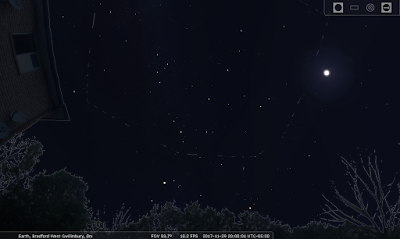Set up in the backyard. In the end, big binoculars on the big tripod. Big winter coat.
The 8:00 PM slot said: cloud cover, 10, clear; transparency, 3, average; seeing, 3/5, average, with the Moon altitude at 46.5.
Good To Stargaze showed low wind, high humidity, no clouds, good seeing and transparency. The temperature was to plummet.
Considered V402 in Lacerta but it was almost overhead.
6:40 PM. Meteor southbound, out of the corner of my eye.
6:43. Was going for V640 Cassiopeiae. At β (beta) Cas I noted lots of tiny delicate doubles to the south. Some at 90 degrees to one another. All similar brightness and similar separations.
[ed: SkyTools 3 Pro shows doubles and multi-star systems here. In the magnitude 7 and 8 range. The nearest is not a double proper but two close stars, including HD 627 and HD 594. The "middle" pair is the multi-star system HD 570 with the B component at 123.3 seconds-of-arc distance. The third set is a wide pair, V742, with a separation of 124.9". Cool!]
Could not split V640.
6:46. I checked ST3P for the details and wondered why it was on the list. This is a very tight pair at 1.6". That would be challenging at the best of times in a large instrument. It is a fast-mover at just over 100 years.
It was nearly straight up. A neck-breaker. That made it even more challenging as I could not view it comfortably.
6:59. Could not split HD 13247 in Triangulum. Wider (at 11") but dimmer (mag 8 and 9).
7:04. Thought I was splitting 7 Persei. There seemed to be a faint companion at the 11 o'clock position.
On subsequent viewing, I started to doubt it.
ST3P said the B star was mag 11.5. D and E were brighter...
I wondered about the mag limit of the Orion Little Giant II binoculars. Perhaps 11?
7:11. On 15 Tri. Got 'em! I was happy. Wide pair, 141.5". Mag 5½ and 7 stars.
Easy target in bins.
Pale orange. B is aquamarine.
West was up for me. The colourful pair was on the end of a large inverted T-shape of stars, with HR 738.
7:18. No joy for ζ (zeta) Per. While the primary was bright, all the companions were very dim.
My legs were cold.
Considered candidates that weren't so high. Went back to the main DS list...
Went inside to warm up. Said hello to Bree. Added some more targets to my observing list.
My feet were cold in my regular boots. Weird. Put on the -100 set.
7:40. Found dew oculars of the binos, sadly, while the sky-facing objectives were fine. Was it my breath or body heat?. Brought a chemical hand warmer to clear the fog.
Viewed phi in Auriga. Nestled in a big flattened triangle of stars, including HR 1795.
Rather cool system. Spotted the B, C, and D stars. They make a triad. B is to the east. C is to the south-east. D was the brightest to the north. C kept fading from view. Sometimes it would pop; sometimes I couldn't see it with averted vision. Very nice. Lovely field.
I wondered about targets in Vulpecula and Sagitta. Wandered to the south-east corner of the yard to take in the sky. Then I felt my mojo go away. Done. Headed back to the gear just as headlights appeared in the driveway...
Pulled some weather data. As of 8:29 PM at Environment Canada observed at the Toronto Buttonville Municipal Airport. Current Conditions 0°C. Condition: Clear. Pressure: 102.8 kPa. Temperature: -0.4°C. Dew point: -4.4°C. Humidity: 74%. Wind: N 5 km/h. Wind Chill: -2. The detailed forecast, issued at 3:30 PM for tonight said, "A few clouds. Wind northwest 20 km/h becoming light early this evening. Low minus 6."
So, not a complete write-off. Got a couple more checked off the DS candidate list. That's good.
Wednesday, November 29, 2017
Subscribe to:
Post Comments (Atom)




No comments:
Post a Comment